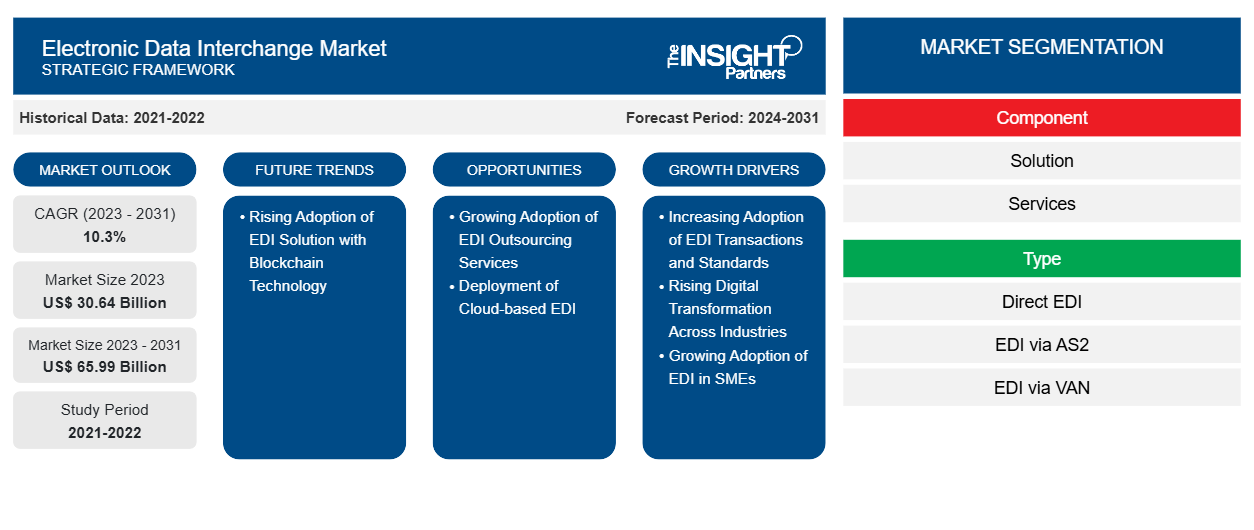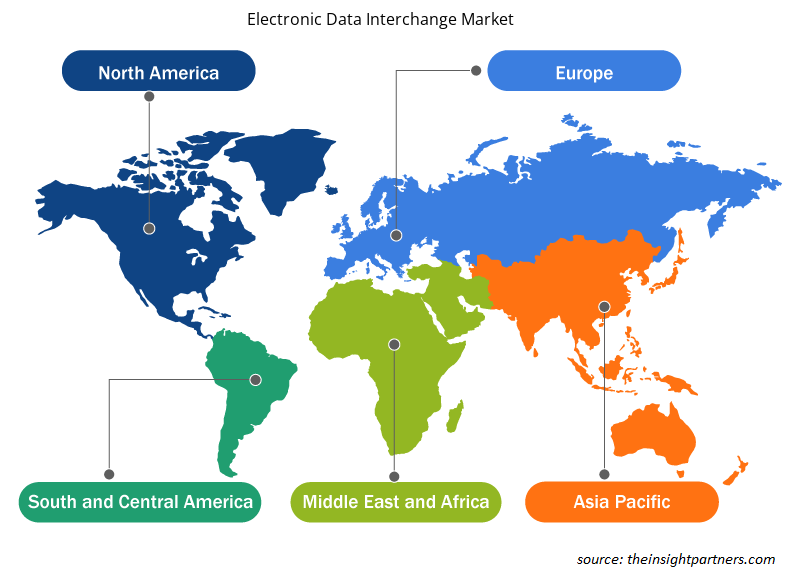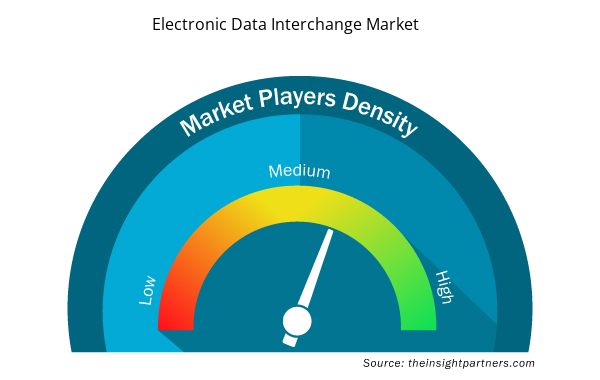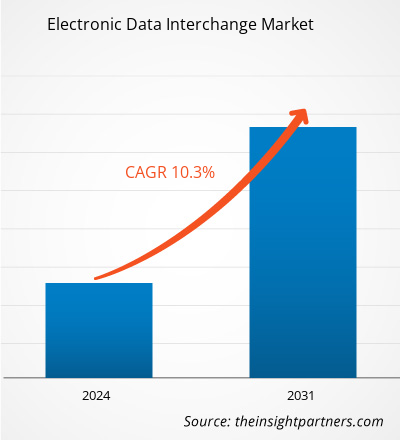The electronic data interchange market size is expected to reach US$ 74.36 billion by 2031 from US$ 34.02 billion in 2024. The market is anticipated to register a CAGR of 11.9% during 2025–2031. The integration of electronic data interchange (EDI) solutions with blockchain technology is likely to bring new trends to the market in the coming years.
Electronic Data Interchange Market Analysis
EDI solutions require constant maintenance as the overall workflow of the organization's business depends on it. Several organizations consider EDI to have adherence to numerous compliances and standards. This hampers smaller businesses from dealing with larger organizations to deploy an updated version of document standards. The organizations are interchanging EDI documents directly with their customers or using third-party service providers. With the growing trend of digitalizing business documents for efficient processing, several compliances are implemented, which boosts the transition from paper-based invoices to electronic invoices worldwide.
The rising digital transformation and acceptance of EDI solutions for data transaction trends across BFSI, retail, and manufacturing industries, along with the rising EDI-related compliance requirements and favorable government initiatives to boost EDI solution adoption, are a few of the critical factors driving the demand for EDI solutions worldwide. However, the disadvantage of EDI is the high implementation cost along with the time-consuming placement of the solutions. Despite these limitations, the increasing adoption of EDI transactions and standards and rising digital transformation across industries are anticipated to fuel the market growth during the forecast period.
Electronic Data Interchange Market Overview
EDI is an automated process for businesses to exchange documents such as invoices, purchase orders, advance ship notices, customs, payment, inventory, bills of lading, and shipping status documents electronically. EDI allows organizations to regulate the exchange of data between supply chain applications. It also guarantees organizations that the business-critical data is sent on time. The EDI replaced traditional business communication with mail preparation and handling. The EDI solutions permit organizations to enhance the overall workflow performance. The fast and accurate processing of EDI documents leads to less repeated work, along with fewer canceled orders and stock-outs.
Customize This Report To Suit Your Requirement
You will get customization on any report - free of charge - including parts of this report, or country-level analysis, Excel Data pack, as well as avail great offers and discounts for start-ups & universities
Electronic Data Interchange Market: Strategic Insights

- Get Top Key Market Trends of this report.This FREE sample will include data analysis, ranging from market trends to estimates and forecasts.
You will get customization on any report - free of charge - including parts of this report, or country-level analysis, Excel Data pack, as well as avail great offers and discounts for start-ups & universities
Electronic Data Interchange Market: Strategic Insights

- Get Top Key Market Trends of this report.This FREE sample will include data analysis, ranging from market trends to estimates and forecasts.
Electronic Data Interchange Market Drivers and Opportunities
Growing Adoption of EDI in SMEs
EDI is utilized regularly among small- and mid-sized businesses. As small and medium enterprises (SMEs) have fewer resources and human capital, EDI supports them in automating processes instead of relying on traditional methods. It enables a variety of documents and data to be shared as per global and regional EDI rules and standards for the entire electronic interchange process. It comprises transmission, message flow, document format, and software utilized to send and receive documents in the SMEs. The growth of SMEs worldwide increases the number of automated transactions, which creates the demand for EDI solutions among SMEs. For instance, according to European Commission (EU) data of July 2024, Europe observed a 5.4% rise in the number of SMEs, with an increase of 4.8% in the employment rate. The total growth of SMEs in the region reached 4.5% between 2021 and 2023. This growth increases the number of business activities and surges the demand for EDI solutions to streamline operations, improve operational efficiency, and reduce excess IT overheads. EDI solutions allow SMEs to seamlessly exchange key documents such as purchase orders and invoices electronically, avoiding manual processes and paperwork. This results in faster order processing, fewer errors, and better inventory management, which improves overall business performance.
Moreover, growing digitalization and rising demand for automated solutions encourage SMEs to adopt cloud-based solutions. Cloud-based solutions automate many aspects of the EDI process—such as validation, data mapping, format translation, streamlining workflows, and reducing manual data entry. As per the Public First survey conducted in 2024, 85% of SMEs using cloud services surveyed agreed that the use of cloud services made it easier for them to compete with larger businesses. The increased adoption of EDI solutions can lead to higher revenue generation for EDI providers. As a result, providers are making EDI solutions more affordable and accessible for expanding their businesses. Further, SMEs investing in EDI enables them to trade with larger organizations while simultaneously handling more business transactions. Overall, EDI helps SMEs operate more efficiently while allowing them to process more transactions and conduct business with larger organizations. Thus, the growing adoption of EDI among SMEs boosts the electronic data interchange market growth.
Growing Demand for EDI Outsourcing Services
The outsourcing of the EDI program is performed via managed services by managing and implementing an EDI platform for a third-party provider. The outsourcing vendor typically offers a cloud-based solution or services that support businesses to securely exchange documents such as purchase orders, invoices, and shipment notices. Outsourcing necessitates the organizations to access a wide range of abilities and capital investment of the hardware and software. Several companies are actively focusing on integrating EDI with their back-office systems, including an ERP system that helps businesses achieve the demand for internal resources. Furthermore, the adoption of managed services approach to EDI has become popular among organizations owing to its significant benefits, such as
- Cloud-based managed EDI outsourced services support businesses to coordinate with trading partners to validate data flow and conduct end-to-end EDI testing
- Provide automatic internal updates as per the changes in the requirement of trading partners
- Support internal monitoring and optimization of EDI transactions and maintenance initiatives
- 24/7 support from trading partners, systems, sales channels, and EDI services experts
- Offers continuous monitoring to minimize data entry and prevent errors
The implementation of EDI outsourcing is more engaging than outsourcing across other areas of the IT industry. The EDI outsourcing aims to reduce the infrastructure cost, ensure accurate and timely data exchange, promote quick adaption to changes in trading partner requirements, and ensure access to appropriate skills for delivering services to the customer. The implementation of EDI outsourcing offers various benefits, such as providing access to the latest technology, getting connected with external systems, and providing access to value-added services to permit the user to trade worldwide. The EDI enhances business agility by allowing users to quickly enter new markets and boost business productivity by supplying advanced information related to performance, the supply chain, and business partners. Therefore, the growing demand for EDI outsourcing services is expected to create an opportunity for the growth of the electronic data interchange market during the forecast period.
Electronic Data Interchange Market Report Segmentation Analysis
The key segments that contributed to the derivation of the electronic data interchange market analysis are component, type, and industry.
- Based on component, the market is divided into solution and services. The solution segment dominated the market in 2024.
- In terms of type, the market is categorized into direct EDI, EDI Via AS2, EDI Via VAN, Mobile EDI, Web EDI, EDI outsourcing, and others. The EDI Via VAN segment dominated the market in 2024.
- Based on industry, the electronic data interchange market is categorized as BFSI, healthcare, retail and consumer goods, IT and telecommunication, transportation and logistics, automotive, food and beverages, and others. The retail and consumer goods segment dominated the market in 2024.
Electronic Data Interchange Market Share Analysis by Geography
The Electronic Data Interchange Market is segmented into five major regions: North America, Europe, Asia Pacific, Middle East & Africa (MEA), and South America. North America dominated the market in 2024.
North America hosts several technological giants that invest significantly in developing robust technologies. With the continuous rise in data transactions in B2C and B2B, many organizations and their partners are projected to report business growth in the future. Many enterprises are showing interest in EDI solutions to interchange their data accurately, efficiently, and safely. The US has several service providers offering automated EDI solutions. The adoption of EDI solutions has resulted in increased efficiency and cost savings across different organizations in the US government. Further, EDI implementation is gradually rising in the region owing to emerging technologies and investments in on-the-cloud systems by organizations.
Electronic Data Interchange Market Regional Insights
The regional trends and factors influencing the Electronic Data Interchange Market throughout the forecast period have been thoroughly explained by the analysts at Insight Partners. This section also discusses Electronic Data Interchange Market segments and geography across North America, Europe, Asia Pacific, Middle East and Africa, and South and Central America.

- Get the Regional Specific Data for Electronic Data Interchange Market
Electronic Data Interchange Market Report Scope
| Report Attribute | Details |
|---|---|
| Market size in 2024 | US$ 34.02 Billion |
| Market Size by 2031 | US$ 74.36 Billion |
| Global CAGR (2025 - 2031) | 11.9% |
| Historical Data | 2021-2023 |
| Forecast period | 2025-2031 |
| Segments Covered |
By Component
|
| Regions and Countries Covered | North America
|
| Market leaders and key company profiles |
Electronic Data Interchange Market Players Density: Understanding Its Impact on Business Dynamics
The Electronic Data Interchange Market is growing rapidly, driven by increasing end-user demand due to factors such as evolving consumer preferences, technological advancements, and greater awareness of the product's benefits. As demand rises, businesses are expanding their offerings, innovating to meet consumer needs, and capitalizing on emerging trends, which further fuels market growth.
Market players density refers to the distribution of firms or companies operating within a particular market or industry. It indicates how many competitors (market players) are present in a given market space relative to its size or total market value.
Major Companies operating in the Electronic Data Interchange Market are:
- Salesforce, Inc. (MuleSoft)
- SPS Commerce, Inc.
- TrueCommerce Inc.
- IBM Corporation
- Cleo
- Generix Group
Disclaimer: The companies listed above are not ranked in any particular order.

- Get the Electronic Data Interchange Market top key players overview
Electronic Data Interchange Market News and Recent Developments
The Electronic Data Interchange Market is evaluated by gathering qualitative and quantitative data post primary and secondary research, which includes important corporate publications, association data, and databases. A few of the developments in the Electronic Data Interchange Market are listed below:
- Cleo announced a partnership with Programmers.io, a leading services provider of AI enablement and technology solutions for businesses across manufacturing, transportation, insurance, and retail. This strategic partnership combines the power of Cleo Integration Cloud (CIC) with Programmers.io's deep technical expertise. Together, the companies will provide tailored EDI and API integrations that seamlessly scale with business operations as customer demands grow.
(Source: Liberty Mutual Insurance, Press Release, March 2025)
- AWS B2B Data Interchange enables one to generate electronic data interchange (EDI) mapping code using generative AI. This new capability expedites the process of writing and testing bi-directional EDI mappings, reducing the time, effort, and costs associated with migrating EDI workloads to AWS. AWS B2B Data Interchange is a fully managed service that automates the transformation of business-critical EDI transactions at scale, with elasticity and pay-as-you-go pricing.
(Source: Liberty Mutual Surety, Press Release, November 2024)
Electronic Data Interchange Market Report Coverage and Deliverables
The "Electronic Data Interchange Market Size and Forecast (2021–2031)" provides a detailed analysis of the market covering the areas mentioned below:
- Electronic data interchange market size and forecast at global, regional, and country levels for all the key market segments covered under the scope
- Electronic data interchange market trends, as well as market dynamics such as drivers, restraints, and key opportunities
- Detailed PEST and SWOT analysis
- Electronic data interchange market analysis covering key market trends, global and regional framework, major players, regulations, and recent market developments
- Industry landscape and competition analysis covering market concentration, heat map analysis, prominent players, and recent developments for the electronic data interchange market
- Detailed company profiles
- Historical Analysis (2 Years), Base Year, Forecast (7 Years) with CAGR
- PEST and SWOT Analysis
- Market Size Value / Volume - Global, Regional, Country
- Industry and Competitive Landscape
- Excel Dataset


- Aircraft Wire and Cable Market
- GMP Cytokines Market
- 3D Mapping and Modelling Market
- Electronic Health Record Market
- Authentication and Brand Protection Market
- Military Rubber Tracks Market
- Constipation Treatment Market
- Point of Care Diagnostics Market
- Embolization Devices Market
- Photo Printing Market

Report Coverage
Revenue forecast, Company Analysis, Industry landscape, Growth factors, and Trends

Segment Covered
Component, Type, Industry

Regional Scope
North America, Europe, Asia Pacific, Middle East & Africa, South & Central America

Country Scope
This text is related
to country scope.
Frequently Asked Questions
What will be the electronic data interchange Market size by 2031?
The electronic data interchange Market is expected to reach US$ 74.36 million in the year 2031.
Which region is holding the major market share of electronic data interchange Market?
The North America held the largest market share in 2024, followed by Europe.
What is the estimated global market size for the electronic data interchange market in 2024?
The electronic data interchange Market was valued at US$ 34.02 billion in 2024 and is projected to reach US$ 74.36 billion by 2031; it is expected to grow at a CAGR of 11.9% during 2025–2031
Which are the key players holding the major market share of electronic data interchange Market?
The key players, holding majority shares, in electronic data interchange Market includes SPS Commerce, Inc., True Commerce, Inc., Mulesoft, LLC, Cleo, and Boomi, Inc.
What are the future trends of the electronic data interchange Market?
Integration of EDI solution with blockchain technology are the future trends of the electronic data interchange Market.
What are the driving factors impacting the electronic data interchange Market?
Increasing adoption of EDI transactions and standards, rising digital transformation across industries, and growing adoption of EDI in SMEs are the driving factors impacting the electronic data interchange Market.
Trends and growth analysis reports related to Technology, Media and Telecommunications : READ MORE..
The List of Companies - Electronic Data Interchange Market
- Salesforce, Inc. (MuleSoft)
- SPS Commerce, Inc.
- TrueCommerce Inc.
- IBM Corporation
- Cleo
- Generix Group
- Comarch SA
- THE DESCARTES SYSTEMS GROUP INC
- EDICOM
- Unifiedpost Group
- Epicor Software Corp
- eZCom Software Inc.
- Amazon Web Services (AWS)
- OpenText
- Lobster Data GmbH

 Get Free Sample For
Get Free Sample For